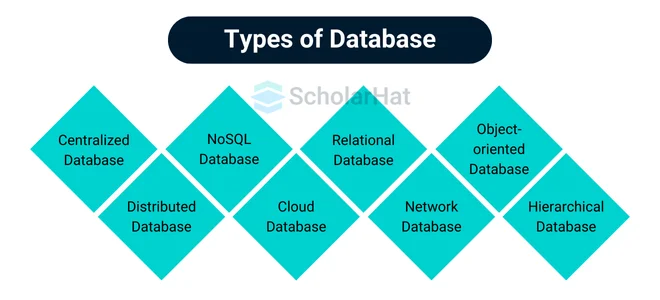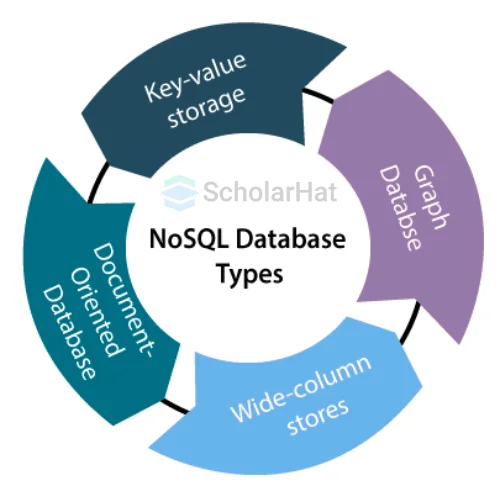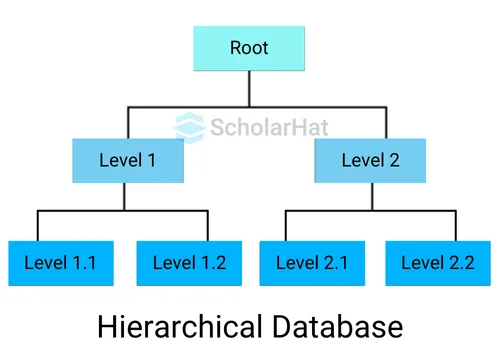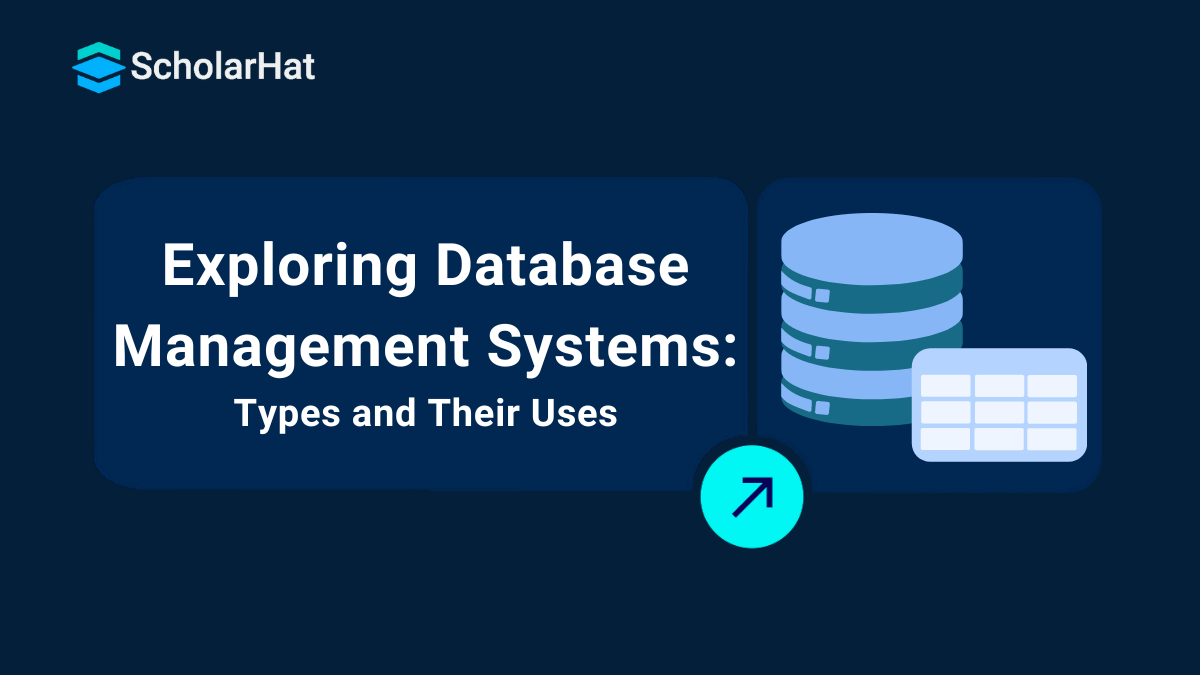29
NovWhat are the 8 Types of DBMS?
Database Management Systems
Database Management Systems (DBMS) are essential for managing and organizing data in a variety of applications. A database management system (DBMS) allows you to efficiently structure, store, and retrieve data while responding to specific needs based on the type of system used. Understanding the various types of DBMS gives a better understanding of how data is managed and optimized for different use cases.
In this database tutorial, we'll examine the different types of database management systems, including an overview of each one, its benefits, and when to use it. So, let's start by exploring "Types of Database Management Systems."
Types of Database Management Systems

- Relational Database Management Systems (RDBMS)
- NoSQL Database Management Systems
- Object-Oriented Database Management Systems (OODBMS)
- Hierarchical Database Management Systems
- Network Database Management Systems (NDBMS)
- NewSQL Database Management Systems
- Multi-Value Database Management Systems (MVDBMS)
- Graph Database Management Systems
Read More - DBMS Viva Questions and Answers
1. Relational Database Management Systems (RDBMS)
- Relational Database Management Systems are built using a relational model, where data is kept in the form of rows and columns inside a table.
- This structure allows an effective way to manipulate and retrieve data through relationships between tables.
- An RDBMS stores data in tables made up of rows and columns.
- Each row represents a record, and each column represents a field or attribute of the record.
- Keys, such as primary and foreign keys, act as the linkage between different tables, maintaining data integrity and corresponding to different pieces of data.
Key Features
- Compatibility for Structured Query Language (SQL): RDBMSs employ SQL, a standard language for querying and administering databases. SQL enables powerful and flexible data manipulation, such as querying, updating, and data definition procedures.
- Data Integrity and Normalization: RDBMSs maintain data integrity through constraints like primary keys and foreign keys. They also support normalization, the process of organizing data to remove redundancy and improve consistency.
Popular RDBMS Examples
- Overview: MySQL is an open-source relational database management system renowned for its speed and dependability. It's widely used in web development and other applications.
- Use Cases: MySQL is used in e-commerce platforms, content management systems, and data warehousing.
- Advantages: MySQL provides high performance, ease of use, a vast community, broad acceptance, and extensive use in open-source projects.
- Overview: PostgreSQL is an advanced open-source RDBMS whose development aims mainly to be extensible while still being fully ACID compliant.
- Use Cases: PostgreSQL is easily used in complex applications, geospatial databases, and financial systems.
- Advantages: PostgreSQL is strongly compliant with SQL and supports more advanced data types. The standard feature set is also very good, with support for JSON and XML.
- Overview: Oracle Database is a commercial RDBMS generally praised for enterprise features and high scalability.
- Use Cases: Mainly used in large-scale enterprise applications, including banking systems and government databases.
- Advantages: Advanced security features, high availability, and comprehensive analytics capabilities.
- Overview: Microsoft SQL Server is a commercial RDBMS integrated with the Microsoft ecosystem.
- Use Cases: Commonly, it is used in business intelligence, data warehousing, and ERP systems.
- Advantages: Integration with Microsoft products is seamless. RDBMS has strong security features and robust support for business analytics.
Real-world Applications
- Therefore, RDBMSs should best serve applications that have structured data and complex queries.
- Customer relationship management systems, inventory management systems, financial transactions, and enterprise resource planning systems are real-world examples of RDBMS use.
- These capabilities of relations in processing and maintaining data integrity make them suitable across a variety of business applications.
2. NoSQL Database Management Systems
- NoSQL Database Management Systems have been designed to manage immense amounts of unstructured or semi-structured data.
- They would also provide flexibility in the design of schema and be scalable, which would be quite apposite in current applications with high performance and fast data access requirements.
- The NoSQL databases have been classified into various kinds based on the various ways to model the data: key-value stores, document-oriented databases, column-family stores, and graph databases.
- Unlike the traditional RDBMSs, a NoSQL database can use a schema-less design and manage diverse data types and structures.

Key Features
- Performance and Scalability: NoSQL databases are scalable horizontally. Essentially, what this means is that with an increase in the number of transactions, the load can be managed by installing the database on more servers.
- Schema Flexibility: Schemas for NoSQL databases are dynamic, and they allow for the storage of unstructured or semi-structured data. By definition, a NoSQL database should not be forced to adhere to a pre-determined schema.
Popular Examples of NoSQL DBMSs
1. MongoDB
- Overview: MongoDB is document-based NoSQL database software. It stores information in a style that is very similar to JSON data objects.
- Use Case: Content management systems, real-time analytics, and IoT applications.
- Advantages: It is schema-less, performs well, is heavily supported by the community, and is easy to scale.
2. Cassandra
- Overview: Apache Cassandra is a distributed NoSQL database designed to be highly available and fault-tolerant.
- Use Cases: Ideal in massive operations of systems and applications that require high availability.
- Benefits: Very high scalability and fault tolerance, well suited for cases that include very huge volumes of data that many nodes generate.
3. Redis
- Overview: In-memory key-value storage is famous for its velocity and data access efficiency.
- Use Cases: Caching, real-time analytics, message brokering.
- Advantages: Very high speed, supports a large number of diverse data structures, and the management of data is quite flexible.
4. Couchbase
- Overview: Couchbase is a distributed NoSQL database that includes good features such as document-oriented and key-value store models.
- Use Cases: The most common ones are mobile apps, real-time processing of data, and web applications.
- Advantages: High performance, excellent throughput, and very good data consistency.
Real-world Applications
- NoSQL databases are more frequently used in applications for big data, social media platforms, and real-time analytics than traditional RDBMSs, which may not perform at scale.
- These databases are ideal for providing flexibility for handling diverse types of data and large volumes of data.
- Object-Oriented Database Management Systems (OODBMS) integrate database functionalities and the characteristics of object-oriented programming to support complex data types that are stored and retrieved as objects.
- Data on OODBMSs are retained in objects, which come from classes.
- These systems support object-oriented programming features such as inheritance, polymorphism, and encapsulation, which allow a more natural representation of complex data structures.
Key Features
- Integration with Object-Oriented Languages: OODBMSs work seamlessly with OOPLs like Java and C++, making it easier to persist and retrieve complex data models.
- Support for Complex Data Types: They support complex data structures and relationships and are suitable for applications with detailed and hierarchical data representations.
Popular OODBMS Examples
- Overview: An object database is one type of database or information collection management system that typically falls into the category of the OODBMS or object-oriented database management system type. In other words, it is a database that is not limited to simple list-objects.
- Use Cases: It is used for building Java applications and Java-based applications that need to have objects stored persistently.
- Advantages: High performance, excellent database access language, and strong integration with Java.
- Overview: db4o is an open-source object database for Java and .NET environments.
- Use Cases: Best used within embedded systems and applications containing complex data models.
- Advantages: It is lightweight, easy to integrate with .NET and Java applications, and efficient in data storage.
Real-world Applications
- OODBMSs find applications that involve complex data relationships and have been built upon the principles of design in an object-oriented manner, like computer-aided design (CAD) systems, multimedia databases, and simulation software.
- They provide a natural means of representing and supporting complex data structures.
- Hierarchical Database Management Systems arrange data in the form of a tree, mimicking parent-child relationships in which every record has only one parent and may have several children.
- A hierarchical DBMS stores data in a hierarchy, with each level of the hierarchy describing a different level of detail. Data retrieval is made by navigating this kind of hierarchical path, and it best fits applications with a clear hierarchical structure.

Key Features
- Data Retrieval Based on Hierarchical Paths: Data is retrieved efficiently by navigating through hierarchical paths from parent to child records.
Popular Hierarchical DBMS Examples
- Overview: IMS is a hierarchical database management system developed by IBM to support the high-performance processing of large databases with enormous volumes of data and records.
- Use Cases: This type of database has found applications in banking, telecommunications, and large-volume transaction processing.
- Advantages: The approach is well-tested, with high performance where data models are naturally
Real-world Applications
- Hierarchical DBMSs are a good choice for applications that have well-defined hierarchical structures, such as organizational charts, file systems, and product catalogs.
- They are especially useful in environments where data relationships are naturally hierarchical.
5. Network Database Management Systems (NDBMS)
- NDBMS applies a network model to represent complex relationships between entities through nodes and connections.
- The network model in NDBMS permits more complicated and flexible data relationships than hierarchical models. Information is represented as a network of connected nodes where each node may have several connections, supporting many-to-many relationships.
Key Features
- Complex Relationships and Data Sharing: This permits complex relations between data and effectively shares data between different interconnected nodes.
Popular Network DBMS Examples
1. Integrated Data Store (IDS)
- Overview: IDS is a network DBMS designed for handling complex data relationships, mainly used in applications with complex data models that require efficient relationship management.
- Advantages: Flexible data modeling and efficient handling of complex relationships.
2. IDMS
- Overview: IDMS is a network DBMS capable of solving complex data relationships. It is used in large-scale enterprise systems and applications with intricate data connections.
- Advantages: Strong support for complex data structures and relationships.
Real-world Applications
- Network DBMSs are helpful in environments where data relationships are complex and interconnected, such as telecommunications, supply chain management, and large-scale enterprise systems.
6. NewSQL Database Management Systems
- So-called NewSQL Database Management Systems try to reconcile the classic relational paradigm with modern requirements for scalability and performance, overcoming some limitations of older RDBMS systems.
- NewSQL databases are designed to maintain traditional RDBMSs with ACID principles, and therefore, they can be scaled horizontally.
- This enables them to handle large quantities of data with high transaction volumes. They aspire to provide strong consistency and scalability at the same time.
Key Features
- High scalability and ACID compliance: Provisions the desired horizontal scalability but, at the same time, maintains the transaction's ACID properties to ensure reliability.
Popular NewSQL DBMS Examples
1. Google Spanner
- Overview: Google Spanner is a NewSQL database that enables global distribution, high consistency, and availability.
- Benefits: Worldwide distribution, strong reliability, and in-built integration with the Google Cloud ecosystem.
2. CockroachDB
- Overview: CockroachDB is a distributed NewSQL database capable of fully realizing high availability and fault tolerance.
- Benefits: Resilience in conjunction with scalability, paired with great support for distributed transactions.
3. NuoDB
- Overview: NuoDB is a distributed database in the NewSQL category, combining the best features from both relational and distributed architectures.
- Key Benefits: Elastic scalability, high availability, and a full SQL interface.
Real-world Applications
- NewSQL databases are best used in applications that handle scale and ensure data consistency, such as financial services, e-commerce, and cloud-based applications.
7. Multi-Value Database Management Systems (MVDBMS)
- Multi-Value Database Management Systems (MVDBMS) store and handle many values for a single field, thus making it more flexible to model data.
- MVDBMSs store more than one value in a single field, supporting more sophisticated data models and reducing the need for complex joins and data normalization.
Key Features
- Support for Complex Data Models: Provides support in handling complex data structures and multi-valued attributes.
Popular MVDBMS Examples
1. Pick the Operating System
- Overview: Pick OS is an MVDBMS known for its flexibility and the management of multi-value data, catering to business applications requiring complex data modeling.
- Advantages: Efficient handling of multi-valued data and flexible data modeling.
2. D3 Database
- Overview: D3 is an MVDBMS that offers robust support for multivalued data and complex data structures applied in financial systems, inventory management, and enterprise applications.
- Advantages: High performance and flexibility, with strong support for complex data relationships.
Real-world Applications
- MVDBMSs are good for applications with complex data requirements, such as business process management, financial systems, and enterprise resource planning (ERP) systems.
8. Graph Database Management Systems
- Graph Database Management Systems (Graph DBMS) are designed to manage data with complex relationships or interconnected structures, making them applicable in managing data where relationships are a core aspect.
- Graph DBMSs structure data as nodes and edges, where nodes represent entities and edges represent relationships between entities.
- This model is particularly useful for querying and managing complex, highly interconnected data.
Key Features
- Efficient Handling of Relationships and Interconnected Data: Offers powerful query capabilities for managing and analyzing complex relationships.
Popular Graph DBMS Examples
1. Neo4j
- Overview: Neo4j is a leading graph database known for its high performance and flexibility in handling graph data.
- Advantages: Powerful Cypher query language, strong community support, and robust graph analytics capabilities.
2. OrientDB
- Overview: OrientDB is a graph database that supports multi-model databases, including document- and graph-oriented functionality.
- Advantages: Flexibility in modeling, support for multiple models, and scalability.
3. Amazon Neptune
- Overview: Amazon Neptune is a fully managed graph database service by AWS, designed for high availability and seamless integration with other AWS services.
- Advantages: AWS integration is highly available to support property graph and RDF graph data models.
Use Cases and Real-world Applications
- Graph databases excel in applications where relationships between data points are of prime importance, such as social networks, fraud detection systems, and recommendation engines.
- Their efficiency in navigating and querying complex data relationships is invaluable in various fields.
| Read Our: Difference Between DBMS and RDBMS |
This database tutorial discusses the different types of Database Management Systems (DBMS), such as Relational, NoSQL, Object-Oriented, Hierarchical, Network, NewSQL, Multi-Value, and Graph DBMSs. Each type is described in detail, including major features, popular examples, and ideal use cases, demonstrating how different DBMSs are tailored for distinct data management needs across a wide range of applications. To implement your understanding, you can consider taking our SQL Server Course and Free MongoDB Certification Course.
FAQs
Take our Dbms skill challenge to evaluate yourself!

In less than 5 minutes, with our skill challenge, you can identify your knowledge gaps and strengths in a given skill.









